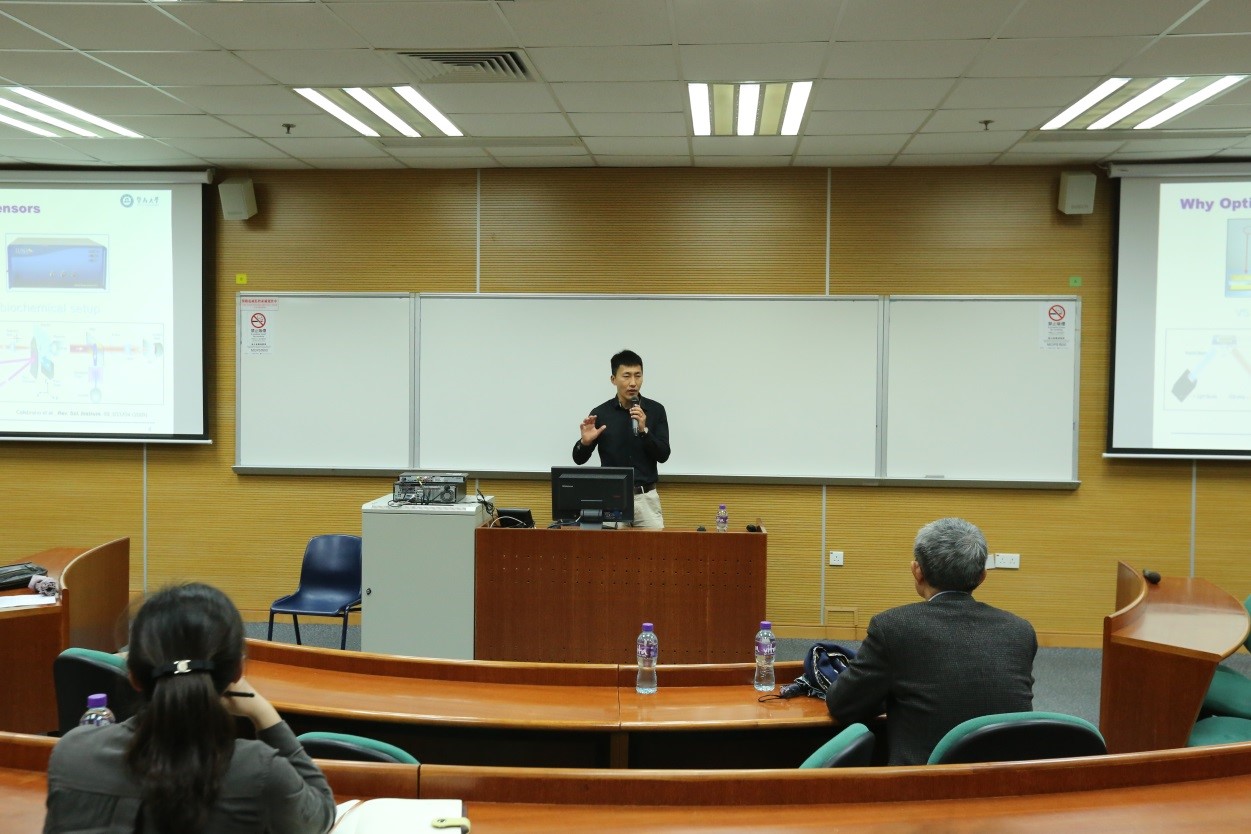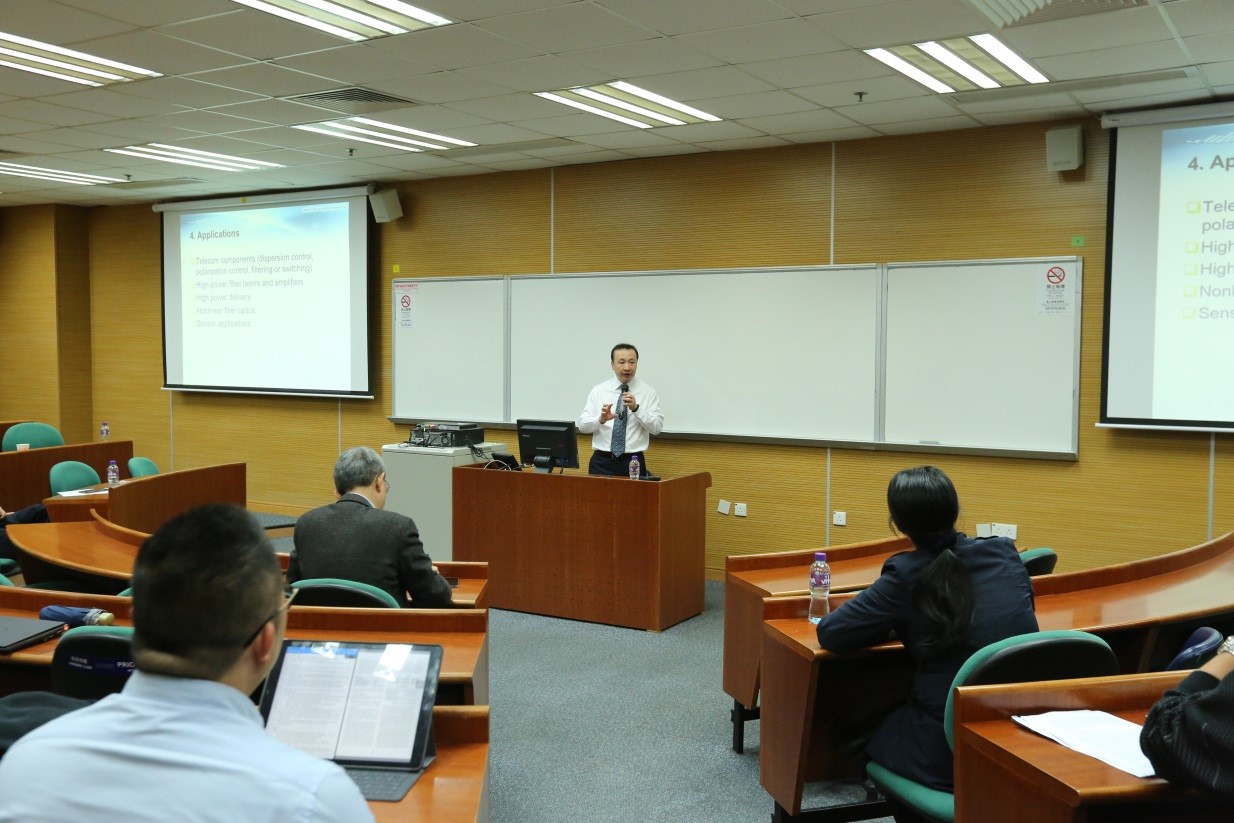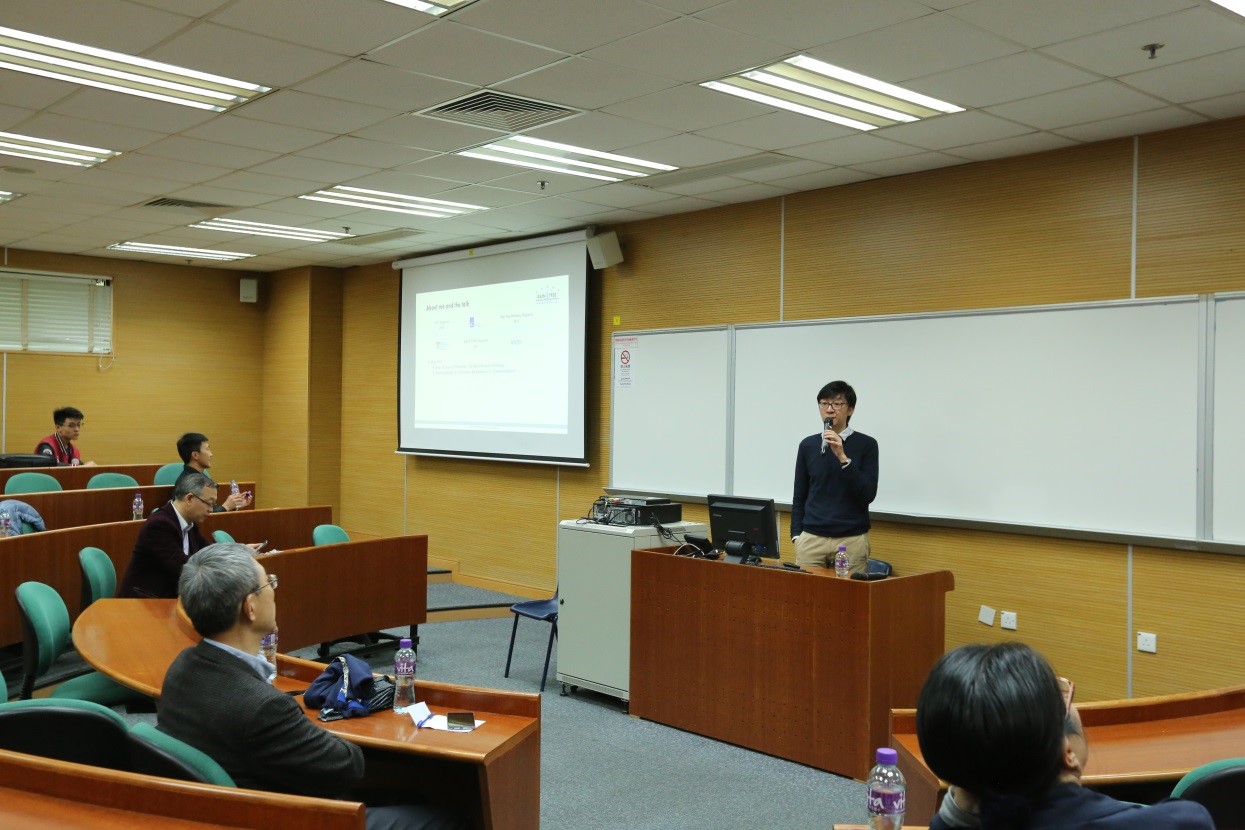为了庆祝澳门科技大学成立18周年,资讯科技学院于2018年3月8日在N座221室举办学术研讨会,幷特别邀请了暨南大学的郭团教授,新加坡南洋理工大学的沈平教授以及新加坡Rain Tree公司董事HuangYing博士担任本次研讨会的演讲嘉宾。他们分别以《Plasmonic optical fiber biochemical and electrochemical sensors》, 《Optical Fiber Sensors》和《Silicon Photonics: A Review from the Commercial Aspect》为题进行了演讲。资讯科技学院院长张渡教授, 助理院长李建庆教授以及师生共40余人出席了研讨会。
郭团教授演讲摘要:
Surface Plasmon resonance (SPR) optical fiber sensors can be used as a cost-effective and relatively simple-to-implement alternative to well established bulky prism configurations for in-situ high sensitivity biochemical and electrochemical measurements. The miniaturized size and remote operation ability offer them a multitude of opportunities for single-point sensing in hard-to-reach spaces, even possibly in vivo. Grating-assisted and polarization control are two key properties of fiber-optic SPR sensors to achieve unprecedented sensitivities and limits of detection. The biosensor configuration presented here utilizes a nano-scale metal-coated tilted fiber Bragg grating (TFBG) imprinted in a commercial single mode fiber core with no structural modifications. Such sensor provides an additional resonant mechanism of high-density narrow cladding mode spectral combs that overlap with the broader absorption of the surface Plasmon for high accuracy interrogation. In this talk, we briefly review the principle, characterization and implementation of plasmonic TFBG sensors, followed by our recent developments of the “surface” and “localized” affinity studies of the biomolecules for real life problems, the electrochemical actives of electroactive biofilms for clean energy resources, and ultra-highly sensitive gas detection.
郭团教授简介:
Tuan Guo is a Professor in the Institute of Photonics Technology, Jinan University, Guangzhou, China. He received the Ph.D. in Optics from Nankai University in 2007. Thereafter he worked as a Postdoctoral Fellow with the Department of Electronics at Carleton University (Canada) and the Photonics Research Centre at The Hong Kong Polytechnic University. He joined the Jinan University as an Associate Professor in 2011 and promoted to a full Professor in 2014. He has authored and coauthored more than 120 papers in the peer-reviewed international journals (included 5 invited reviews) and presented over 20 invited talks at international and national conferences. He holds 15 patents and pending patents. His research activities include optical fiber sensors, fiber lasers, fiber gratings, plasmonics, biophotonics, optofluidics. He was a Co-Chair of the IEEE Photonic Technology in Instrumentation and Measurement technical committee, an Associated Editor for Journal of Sensors from 2010 to 2014 and a Guest Editor for a Special Issue on “Recent Advances in Fiber Bragg Grating Sensing” for MDPI Sensors in 2016. He is a Senior Member of IEEE and a Senior Member of Optical Society of America (OSA)..
沈平教授演讲摘要:
Optical fiber-based devices have been widely deployed in recent years. There are many advantages of using fiber as a sensor. These include electrically-passive operation, light weight, immunity to radio frequency interference and electromagnetic interference, high sensitivity, compact size, corrosion resistance, easily multiplexing and potentially low cost. Several novel fiber-based sensors and technologies developed are presented here, including fiber Bragg grating (FBG) based sensors, photonic crystal fiber (PCF) based sensors, specialty fiber-based sensors and distributed fiber sensing systems. FBGs as instinctive sensors, are ingeniously designed as two-dimensional (2D) tilt sensors, displacement sensors, accelerometers and corrosion sensors here; PCF based evanescent field absorption sensor, PCF induced Mach-Zehnder interferometer and Fabry-Perot refractometer for temperature and refractive index sensing are presented; based on localized surface Plasmon resonant (LSPR) effect, nano-sized fiber tip with gold nanoparticles are demonstrated for live cell index bio-sensing applications.
沈平教授简介:
Prof Shum received his PhD degree in Electronic and Electrical Engineering from the University of Birmingham, UK, in 1995. In 1999, he joined the School of Electrical and Electronic Engineering, NTU. Since 2014, he has been appointed as the Director of Centre for Optical Fibre Technology and was the chair, committee member and international advisor of many international conferences. He was also the founding member of IEEE Photonics Society Singapore Chapter (formerly IEEE LEOS). He is currently the chairman of OSA Singapore Chapter. Prof Shum has published more than 500 journal and conference papers with his research interests being in the areas of speciality fibres and fibre-based devices. His H-index is 38. In recent few years, his publications have been cited about 500-800 times per year. He is SPIE Fellow and OSA Fellow.
Huang Ying博士演讲摘要:
Silicon Photonics technology has attracted tremendous global research and industrial attentions recently. Leveraging on the mature complementary metal-oxide-semiconductor (CMOS) infrastructure for microelectronics industry today, the technology has the potential to revolutionize the photonics industry with low-cost, compact and high-performance photonics integrated circuit (PIC). After decades of development, the technology has reached the inflation point in recent few years, with various commercial product entering the mass market for tele-com, cloud data-center and sensor applications. This talk aims to provide a view of the technology from the commercial aspect. Topics include a general overview of the technology, its market perspective and a review of the different commercial effort to implement real-world products with the technology.
Huang Ying博士简介:
Dr Huang Ying received the B.E. and Ph.D. degree in Electrical and Electronic Engineering from Nanyang Technological University (NTU), Singapore, in 2007 and 2011, respectively. From 2011-2017, he was with the Institute of Microelectronics, Agency for Science, Technology and Research (A*STAR), Singapore, as a research scientist and principle investigator. He was responsible for setting-up the silicon photonics platform there, which is widely used by universities, research institutes, start-ups and MNCs to great success today. In 2017, Dr. Huang co-founded Rain Tree Photonics, Singapore, a start-up leveraging silicon photonics technology for data-com and sensor applications. Dr. Huang’s research focuses on the design and process integration of silicon photonics devices for telecom, data-com, sensors and Quantum applications. He has authored and co-authored more than 50 journal and conference publications. Dr. Huang was the recipient of the prestigious AGS graduate scholarship award from A*STAR for his Ph.D. study.

郭团教授在演讲中

沈平教授在演讲中

Huang Ying博士在演讲中
